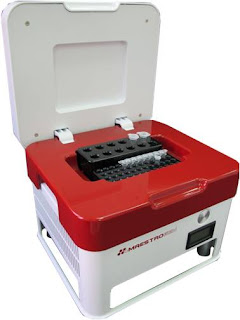Nucleic Acid
GRiSP offers one of the most innovative and high performance options on the market for directPCR applications - Xpert directXtract PCR Kit.
One of the main applications for this kit (despite not limited to) is Mouse Genotyping. Not only it's an application with intensive reagent numbers consumption, but also one where time is highly relevant.
The workflow, show in the flyer on the left, contains three steps, and a total time of only 90 minutes.
It consists on the combination of GE60 (Xpert directXtract PCR Kit) and GB01 (SGTB DNA Electrophoresis Buffer).



Improved management of hepatitis D

HDV is a small, defective RNA virus that can infect only individuals who have HBV; worldwide
more than 15 million people are co-infected. HDV increases the severity of chronic HBV infection,
frequently leading to cirrhosis, hepatic decompensation or hepatocellular carcinoma. The prevalence
of HDV is declining in some endemic areas but increasing in northern and central Europe
because of immigration. Interferon-alpha is currently the only available treatment option leading
to suppression of HDV RNA in 25 % - 30 % of patients [
![]() Improved management of hepatitis D
Improved management of hepatitis D
![]() ExpressArt® mRNA amplification technology for intact RNA: How does it work?
ExpressArt® mRNA amplification technology for intact RNA: How does it work?
|
Briefly, ExpressArt ® technology for Standard kits is based on the following steps: Conversion of mRNA to cDNA is achieved with an anchored oligo(dT) primer in the first reverse transcription reaction. No promoter sequence is present in the primary cDNAs. Then, all RNAs (including mRNAs and rRNAs) are digested with a mixture of heat-labile RNases. Single stranded cDNAs are converted to double stranded DNAs with a special primer construct, the TRinucleotide primer (BOX-random-3'-trinucleotide). This 30-mer primer contains a unique 21-mer BOX, followed by six random nucleotides, and a trinucleotide sequence at the 3'-end. We use a mix of several primers with different 3'-terminal trinucleotides. The trinucleotides determine potential primer elongation sites, that are discontinuously distributed over annealed templates. Consequently, preferential priming near the 3'-end of the template occurs. To minimise primerderived artefacts, the T7-promotor sequence is introduced only in the 2nd synthesis of dsDNA. This double stranded cDNA is the template for the first amplification by in vitro transcription. All amplified RNAs contain the same 3'-terminal 21-mer BOX sequence. For second and third amplification rounds, full-length cDNAs are obtained using this 21-mer BOX sequence as primer. RNA removal (with heat-labile RNases) is followed by second strand cDNA synthesis, introducing a T7-promotor sequence in double stranded cDNA templates for second (or third) amplification by in vitro transcription.
|
 |















